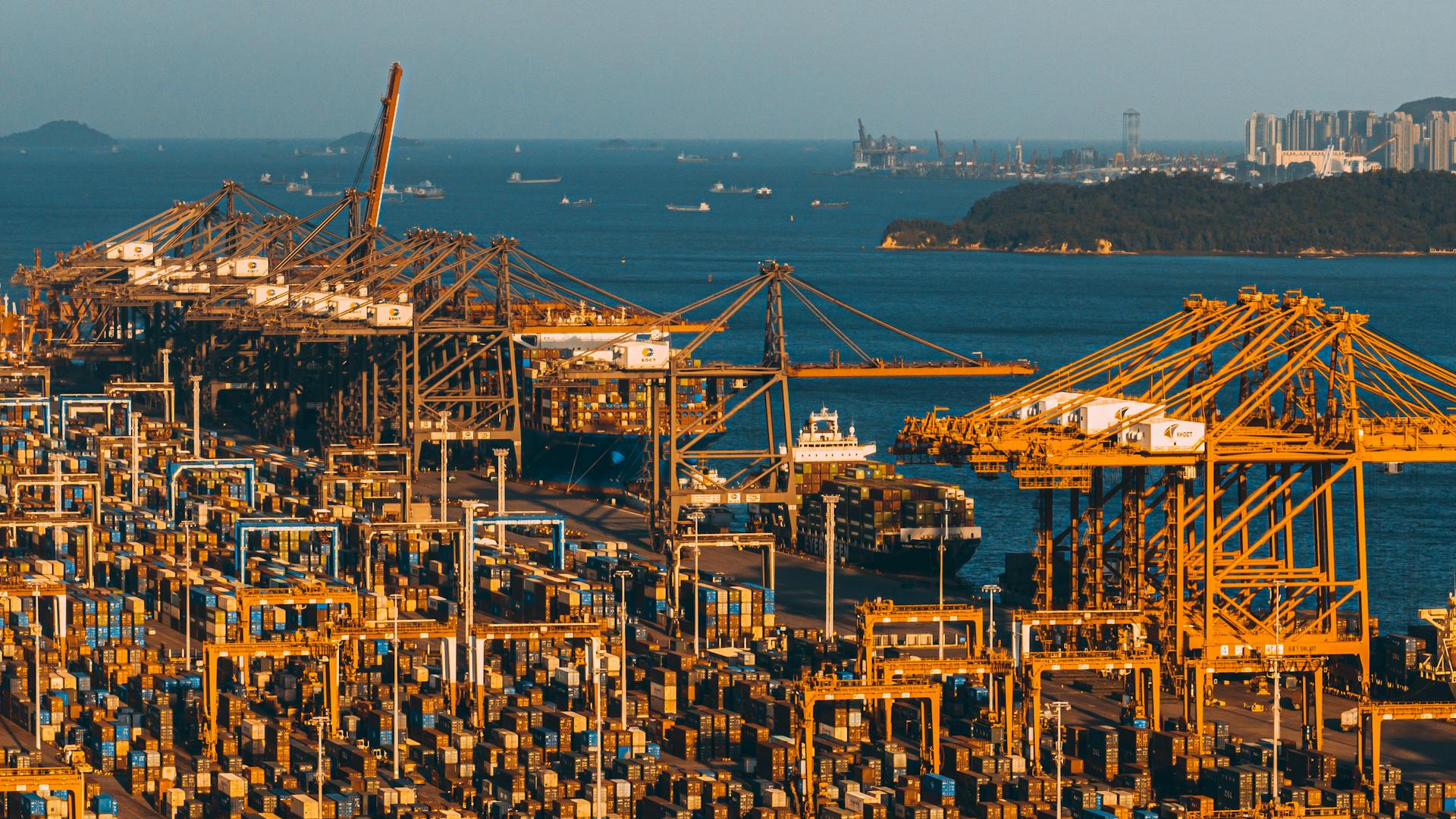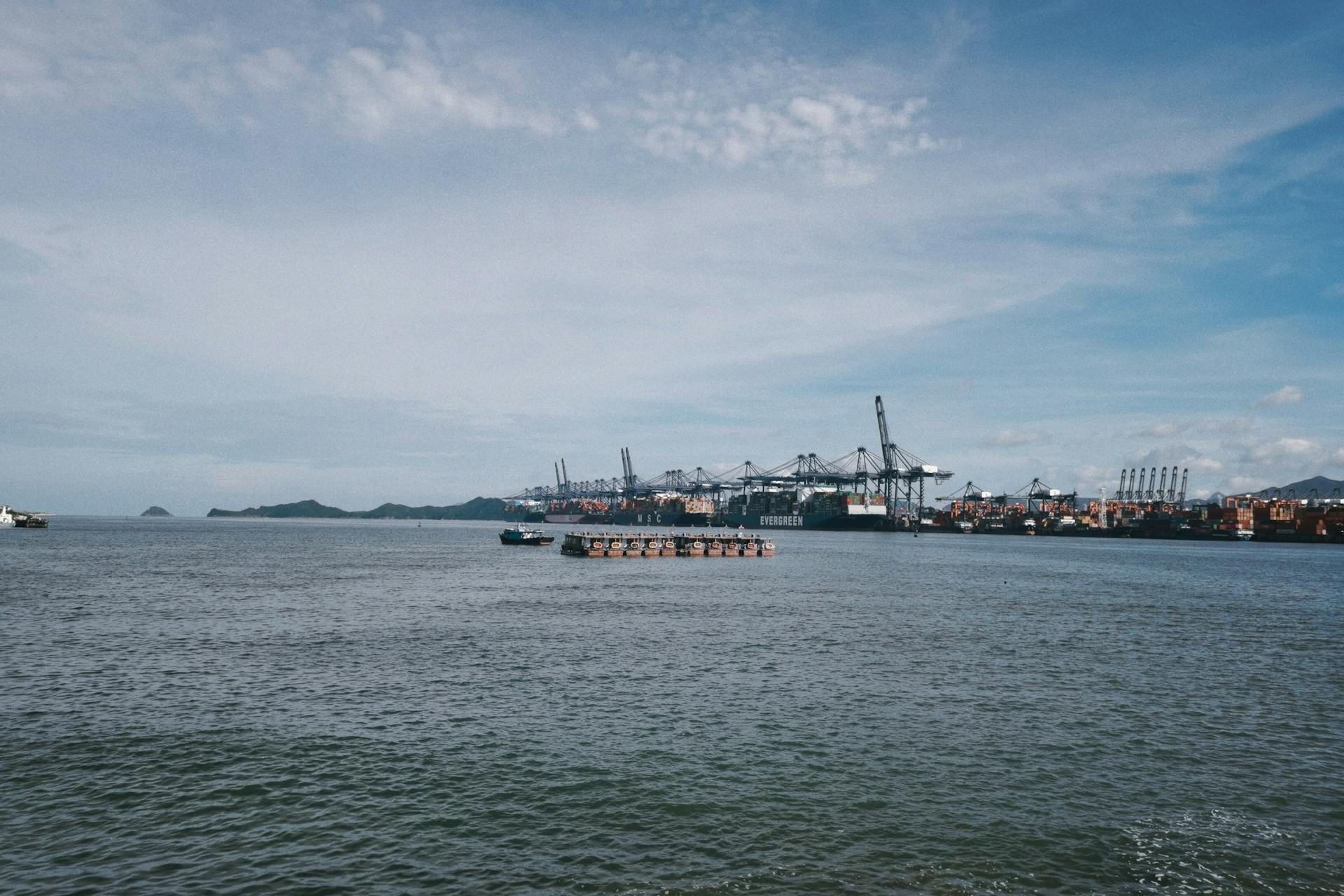
China's automated ports are revolutionizing the shipping industry, and it's exciting to think about what the future holds. The first automated port in China was the Tianjin Port, which opened in 2015 and featured a fully automated container terminal.
The port's automated systems can handle up to 1,000 containers per hour, a significant increase from the 300 containers per hour that human workers could handle. This efficiency boost has reduced labor costs and increased productivity.
China's automated ports are designed to be more resilient to natural disasters and economic downturns, as they can operate with minimal human intervention.
China's Automation Efforts
China is leading the world in the number of automated terminals, with 18 in operation and 27 under construction or being upgraded. This is a testament to its maritime prowess and technological advancements.
The Chinese government has made a strategic effort to turn its ports into the most advanced in the world, capable of handling growing volumes of goods with decreasing manpower. By 2022, Tianjin Port had introduced fully autonomous trucks capable of operating 24/7, regardless of weather conditions.
China's reliance on automated gantry cranes has slashed loading times, reduced labor costs, and minimized human error, pushing it far ahead in the race for efficiency. Dr. Wang Jian, a logistics expert at Tsinghua University, notes that the level of automation in Chinese ports is "staggering".
The Qingdao Port in Shandong Province is a prime example of China's leadership in automation, with an air-track intelligent transporting system capable of handling 1.5 million TEUs each year. This system is entirely domestically designed and constructed, with over 28,000 components and core equipment sourced from within the country.
The Xiamen Yuanhai container terminal is one of the first fourth-generation automated terminals in the world, operating on a fully automated system that blends cutting-edge information technology with port operations. This system has achieved substantial operational efficiency, with manual adjustments accounting for less than five percent.
In 2023, China's ports handled over 257 million TEU containers, a 4.9 percent increase from the previous year.
The Automation Trend
China's ports are leading the way in automation, with the country's reliance on automated gantry cranes slashing loading times and reducing labor costs by nearly 50% compared to traditional ports in the U.S.
The level of automation in Chinese ports is staggering, with unloading times reduced by over 30%. This is a significant improvement over traditional ports, where labor disputes and an aversion to automation have hindered progress.
The Chinese government's strategic embrace of port autonomy has resulted in a comprehensive effort to turn Chinese ports into the most advanced in the world, capable of handling growing volumes of goods with decreasing manpower.
At Tianjin Port, for example, fully autonomous trucks are operating 24/7, regardless of weather conditions. This is a major breakthrough in port efficiency and a testament to China's commitment to automation.
The transition to automation in U.S. ports has been piecemeal at best, hindered by labor disputes and fears of job losses. This has left the country lagging behind China in terms of port efficiency and autonomy.
America Must Catch Up
The United States is facing a pressing issue in the realm of autonomous shipping ports, as China is rapidly modernizing its ports to stay ahead in the global economy.
China's ports are responsible for handling nearly 30% of the world's container shipping volume, making them pivotal assets in Beijing's Belt and Road Initiative.
The future of trade and the global economy will be determined by which nation can best adapt to the challenges of the 21st century, and right now, China is winning that race.
For the United States, the question is no longer whether to modernize, but whether it can do so quickly enough to stay in the game.
Frequently Asked Questions
What is the most automated port in the world?
The Port of Shanghai's Yangshan Deep-Water Terminal is the most automated port in the world, utilizing unmanned cranes, self-driving trucks, and 5G networks to streamline operations. This automation enables Shanghai to process containers 40% faster than traditional manual ports.
What are the 5 treaty ports in China?
The Treaty of Nanking designated five ports in China for foreign trade: Canton (Guangzhou), Amoy (Xiamen), Foochow (Fuzhou), Ningpo (Ningbo), and Shanghai. These ports played a significant role in China's opening to the world during the 19th century.
Sources
- https://news.cgtn.com/news/2024-01-29/China-leads-world-s-automated-container-terminals-amid-smart-tech-boom-1qLvtCara0g/p.html
- https://substack.com/home/post/p-149951423
- https://equalocean.com/analysis/2022082618801
- http://en.people.cn/n3/2025/0114/c90000-20265962.html
- http://regional.chinadaily.com.cn/ensd-port/2023-12/28/c_1008557.htm
Featured Images: pexels.com


